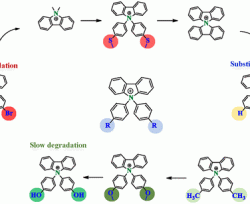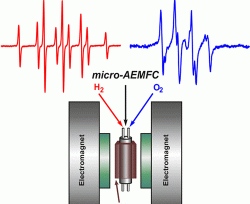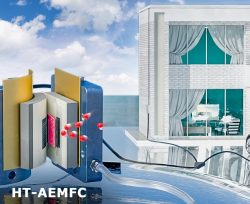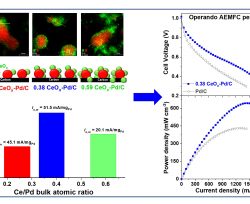Authors: Jaana Lilloja, Elo Kibena-Põldsepp, Ave Sarapuu, John C. Douglin, Maike Kaärik, Jekaterina Kozlova, Paärn Paiste, Arvo Kikas, Jaan Aruvali, Jaan Leis, Vaino Sammelselg, Dario R. Dekel, Kaido Tammeveski
Transition-metal- and nitrogen-codoped carbide-derived carbon/carbon nanotube composites (M-N-CDC/CNT) have been prepared, characterized, and used as cathode catalysts in anion-exchange membrane fuel cells (AEMFCs). As transition metals, cobalt, iron, and a combination of both have been investigated. Metal and nitrogen are doped through a simple high-temperature pyrolysis technique with 1,10-phenanthroline as the N precursor. The physicochemical characterization shows the success of metal and nitrogen doping as well as very similar morphologies and textural
Authors: Reio Praats, Maike Käärik, Arvo Kikas, Vambola Kisand, Jaan Aruväli, Päärn Paiste, Maido Merisalu, Ave Sarapuu, Jaan Leis, Väino Sammelselg, John C. Douglin, Dario R. Dekel, Kaido Tammeveski
In this work, composite materials based on carbide-derived carbon (CDC) and carbon nanotubes (CNT) modified with Co phthalocyanine (CoPc) were employed as electrocatalysts towards the oxygen reduction reaction (ORR) in both alkaline and acid media. Two different CDCs derived from titanium carbide and silicon carbide were used and the CDC-to-CNT ratio was varied in the composite materials. The final catalysts were obtained after pyrolysis at 800 °C. The catalyst materials were characterised by scanning
Authors: Eliran R. Hamo, Ramesh K. Singh, John C. Douglin, Sian Chen, Mohamed Ben Hassine, Enrique Carbo-Argibay, Shanfu Lu, Haining Wang, Paulo J. Ferreira, Brian A. Rosen, Dario R. Dekel
Owing to the sluggish kinetics of the hydrogen oxidation reaction (HOR) in alkaline electrolyte, it is considered a limiting reaction for the development of anion-exchange membrane fuel cell (AEMFC) technology. Studies of alkaline HOR catalysis mainly focus on carbon-supported nanoparticles, which have weak metal–support interactions. In this contribution, we present a unique support based on transition metal carbides (TMCs = Mo2C, Mo2C–TaC, and Mo2C–W2C) for the HOR. PtRu nanoparticles are deposited onto
Authors: Manar Halabi, Meirav Mann-Lahav, Vadim Beilin, Gennady E. Shter, Oren Elishav, Gideon S. Grader, and Dario R. Dekel
Anion-conducting ionomer-based nanofibers mats are prepared by electrospinning (ES) technique. Depending on the relative humidity (RH) during the ES process (RHES), ionomer nanofibers with different morphologies are obtained. The effect of relative humidity on the ionomer nanofibers morphology, ionic conductivity, and water uptake (WU) is studied. A branching effect in the ES fibers found to occur mostly at RHES < 30% is discussed. The anion conductivity and WU of the ionomer electrospun mats prepared at the lowest RHES are found to be higher than
Authors: Nansi Gjineci, Sinai Aharonovich, Dario R. Dekel, Charles E. Diesendruck
Anion-exchange membrane fuel cells (AEMFCs) have attracted the attention of the scientific community during the past years, mostly because of the potential for eliminating the need for using costly platinum catalysts in the cells. However, the broad commercialization of AEMFCs is hampered by the low chemical stability of the cationic functional groups in the anion-conducting membranes required for the transportation of hydroxide ions in the cell. Improving the stability of these groups is directly connected with the ability to recognize the different mechanisms of the OH– attack. In this work, we
Authors: Udit N. Shrivastava, Avital Zhegur-Khais, Maria Bass, Sapir Willdorf-Cohen, Viatcheslav Freger, Dario R. Dekel, Kunal Karan
Typically, in polymer electrolyte-based electrochemical devices such as electrolyzers and fuel cells, ionomers in the catalyst layers are present as ultrathin films coating the electrochemically active component. Acidic ionomer thin films have been extensively characterized over the past decade, yet there are few reports on the alkaline ionomer thin films. Here, we present a study on anion-exchange ionomers; specifically, we investigate the water content and conductivity of fluoride, bromide, and carbonate forms of 50 nm thick FAA3 and PPO ionomer thin films at 30
Authors: Florian D. Speck, Farhan S. M. Ali, Michael T. Y. Paul, Ramesh K. Singh, Thomas Böhm, André Hofer, Olga Kasian, Simon Thiele, Julien Bachmann, Dario R. Dekel, Tanja Kallio, Serhiy Cherevko
Various bifunctional metal-oxide composites have recently been proposed as advanced hydrogen oxidation reaction (HOR) electrocatalysts for anion-exchange membrane fuel cells (AEMFCs). It is postulated that metal and oxide are active sites for the adsorption of hydrogen/proton and hydroxide ions, respectively. Of particular interest are the so-called buried interfaces. To investigate processes governing activity and stability at such interfaces, we prepare model Pd and Pt electrocatalysts which are fully covered
Authors: Szymon Wierzbicki, John C. Douglin, Aldona Kostuch, Dario R. Dekel, Krzysztof Kruczała
In this paper we present a study on stable radicals and short-lived species generated in anion-exchange membrane (AEM) fuel cells (AEMFCs) during operation. The in situ measurements are performed with a micro-AEMFC inserted into a resonator of an electron paramagnetic resonance (EPR) spectrometer, which enables separate monitoring of radicals formed on the anode and cathode sides. The creation of radicals is monitored by the EPR spin trapping technique. For the first time, we clearly show the formation and presence of stable radicals in AEMs during and after long-term
Authors: John C. Douglin, John Varcoe, Dario R. Dekel
In the past few years, developments in anion exchange membranes (AEMs) have led to a significant increase in hydroxide conductivities, ultimately yielding striking improvements in the performance of anion exchange membrane fuel cells (AEMFCs) at low operating temperatures, usually at 40–80 °C. Aside from these remarkable achievements, the literature is void of any work on AEMFCs operated at temperatures above 100 °C, despite the consensus from various models remarking that working at higher cell temperatures may lead to many significant advantages. In this work, we present the first high-temperature AEMFC (HT-AEMFC) tested at 110 °C. The
Authors: Ramesh K. Singh, Elena S. Davydova, John Douglin, Andres O. Godoy, Haiyan Tan, Marco Bellini, Bryan J. Allen, Jasna Jankovic, Hamish A. Miller, Ana C. Alba‐Rubio, Dario R. Dekel
Due to the sluggish kinetics of the hydrogen oxidation reaction (HOR) in alkaline electrolytes, the development of more efficient HOR catalysts is essential for the next generation of anion‐exchange membrane fuel cells (AEMFCs). In this work, CeOx is selectively deposited onto carbon‐supported Pd nanoparticles by controlled surface reactions, aiming to enhance the homogenous distribution of CeOx and its preferential attachment to Pd nanoparticles, to achieve highly active CeOx‐Pd/C catalysts. The catalysts are characterized by







